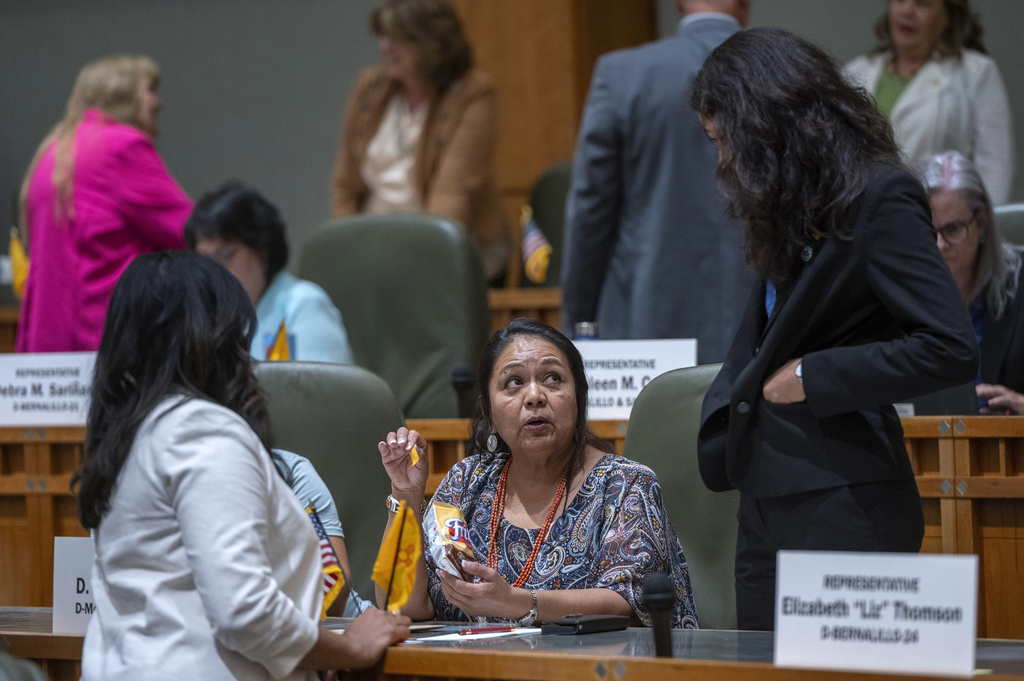Women Secure Historic Majority in New Mexico Legislature \ Newslooks \ Washington DC \ Mary Sidiqi \ Evening Edition \ New Mexico has set a U.S. record with women winning 60 seats in its state Legislature, marking a significant female majority. This surge includes both Democrats and Republicans, highlighting continued gender representation growth nationwide. Female legislators in New Mexico join a tradition of women in high state roles, reinforcing political diversity and policy-making.

Women’s Historic Legislative Milestone in New Mexico: Quick Looks
- Historic Achievement: Women now hold 60 out of 112 seats in the New Mexico Legislature, the largest female majority in U.S. legislative history.
- New Members: Eleven additional women were elected, bolstering female representation with a bipartisan mix.
- Female Senate: Despite the majority in the Legislature, women still hold a minority in the state Senate with 16 out of 42 seats.
- Nationwide Context: The 2018 elections marked a significant leap in female state representation, driven by the #MeToo movement and Trump’s election.
- Precedent in Nevada: Nevada was the first state to achieve a female legislative majority, now holding over 60% of its seats.
- National Figures: As of the recent election, women comprised 33% of state legislative seats nationwide, up from 11% in 1980.
- Notable Winners: Republican Nicole Chavez and Democrat Heather Berghmans, both advocating for distinct political and community causes, were among the new legislators.
- Candidate Experiences: Berghmans emphasized public interest in younger female candidates, while Chavez underscored diversity in political perspectives.
- Advocacy and Challenges: Chavez, a crime victims’ advocate, and Berghmans, focused on housing and childcare, represent a new generation of leadership.
- Emerge Training: Programs like Emerge have played a critical role in preparing female candidates for successful campaigns in New Mexico and beyond.
Deep Look
The 2024 election outcome adds 11 women to New Mexico’s legislative body, advancing gender diversity and political inclusion. Although women will still hold a minority in the state Senate—16 out of 42 seats—the overall representation cements New Mexico’s position as a leader in gender parity within politics.
This record follows a decades-long trend of incremental gains for women in state legislatures, with a noteworthy surge during the 2018 election cycle, primarily fueled by Democratic female candidates amid the #MeToo movement and a wave of activism inspired by Donald Trump’s presidency. In 2018, Nevada became the first state to achieve a female legislative majority and has since expanded to more than 60% representation, leading the way with female majorities in both legislative chambers. New Mexico’s 54% female majority is significant, especially given its larger number of seats.
Among the newly elected New Mexico legislators is Republican Nicole Chavez, a long-time advocate for crime victims whose personal story and legislative mission stem from tragedy. Chavez, who lost her eldest son, Jaydon, in a 2015 shooting, has championed victims’ rights at the state level. This year, she ran on a platform promoting enhanced penalties for serious crimes and incentives for businesses that employ people post-incarceration to reduce recidivism. As her district’s first Latina legislator-elect, she highlights the importance of diverse representation, balancing her celebration of the historic female majority with an emphasis on broad political values. “I don’t believe in just recruiting women,” Chavez noted. “I think we should have diversity of all values.”
Democrat Heather Berghmans, who won her seat by defeating male opponents in both the primary and general elections, will join the state Senate as its youngest member at age 36. With a background in public policy and an early career in e-commerce, Berghmans campaigned on resolving critical issues such as homelessness and housing affordability. Her grassroots campaign resonated with voters who expressed a readiness for fresh perspectives. “People are excited to see new ideas and new faces,” she shared, emphasizing that many voters specifically cited her identity as a young woman as a factor in their support.
Programs such as Emerge have been instrumental in training and preparing women to run for office. This initiative, active in New Mexico, provides comprehensive support encompassing financial strategy, messaging, and resilience training—fostering a network that helps female candidates overcome the challenges of campaigning. Democratic state Rep. Reena Szczepanski, a graduate of Emerge and former executive director of its local chapter, credited the program’s impact on her and many colleagues. Emerge graduates, such as state public land commissioner Stephanie Garcia Richard, showcase the long-term influence of such training on female political trajectories.
Women in New Mexico have also gained prominence in other top government roles, such as the governor’s office, which has been held by women for four consecutive terms. Additionally, three of the five state Supreme Court seats are occupied by women. Other key offices, including secretary of state, state treasurer, and public land commissioner, are held by women, further demonstrating a trend toward balanced representation.
Kelly Dittmar, director of research at the Center for American Women and Politics, noted that it’s too soon to fully analyze national changes in female representation following the election, with vote counts still ongoing. However, this record in New Mexico contributes to the broader trend of growing female influence in legislative chambers. States like Arizona and Colorado have also experienced brief periods of female majorities in recent years, hinting at a future where gender parity in state governance becomes the norm.
Women Secure Women Secure Women Secure







